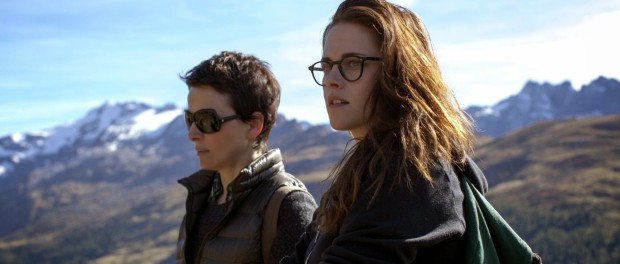Review of Clouds of Sils Maria: Artistic Angst in the Alps
Labeling the movie Clouds of Sils Maria as an art film could be construed as not just a compliment but also a handicap in terms of its chances for box office success. Films like this, which despite being praised by critics and cinema scholars, usually don’t do well with mainstream audiences. To say that Clouds of Sils Maria will appeal to a limited audience is an understatement. The film, which was directed by Olivier Assayas, stars Academy Award winner Juliette Binoche, Kristen Stewart, and Chloe Grace Moretz.
The plot of Clouds of Sils Maria revolves around Maria Enders, a middle-aged actress (Binoche) and the complex relationship she has with her young personal assistant Valentine (Stewart). Apparently Assayas wrote the lead role with Binoche (who won an Oscar in 1997 for her supporting role in The English Patient) in mind. As the narrative progresses the film focuses on Maria and Valentine’s professional and personal relationship which becomes even more enmeshed when the women begin rehearsing a play involving a lesbian relationship between an older and younger woman (art imitating life?).
Clouds of Silas Maria could have been a much better film than it turned out to be. The script deals with a number of interesting ideas (i.e. female friendship, how opinions and perceptions change as people age, the relationship between art and life, grief, today’s internet and pop culture obsessed society, as well as the difficulties of being an older actress in an industry that values youth and appearance). Kristen Stewart is particularly good in this film. Like her Twilight co-star Robert Pattinson, the young actress has been trying to break out of her status as a teen star and tackle more adult and serious roles. Stewart was rewarded for her efforts by becoming the first American to win a French Cesar award for best supporting actress for this film.
Despite all that Clouds of Silas has going for it, the film suffers from the fatal flaw of taking itself too seriously. It’s also hopelessly mired down in pretentiousness and an inflated sense of importance which is compounded by the filmmaker’s decision to use title cards (i.e. “Part 2”) along with a number of fade outs which seem to happen at random moments and without explanation. There’s also a number of scenes in Clouds of Sils Maria which are totally incongruous with the rest of the film and serve only to disrupt the fluidity of the narrative. One such puzzling sequence involves Valentine driving along a foggy highway when out of the blue she pulls over, gets out of her car, and throws up by the side of the road.
Another significant problem with the film is how it deals with the subject of love between women. Although the topic of lesbianism is brought up (especially regarding the play Maria is working on) the filmmaker doesn’t address the issue directly in terms of the actress’ feelings for Valentine. It’s as if the storyline leads viewers down a specific path only to be abandoned when the film fails to live up to its promise.
The plot of Clouds of Silas Maria is as vaporous as the weather phenomena alluded to in the title. The real star of the film is the beautiful Swiss scenery. The Alps have never looked so picturesque. It’s just too bad that the locale couldn’t save this wordy and unsatisfying “art” film.







